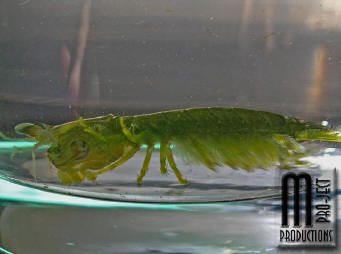chrissaysyes
Nereus
Getting ready to do some research on account of my soon to be new pet Odontodactylus scyllarus so I thought I may share all the information I dig up. I will be reporting on four of the most prominent species (and readily available) for home aquariums.
Stomatopods:
Stomatopods (only distantly related to the other crustaceans which are real shrimp) get their insectorial appellation from their specialized forelimbs. Held up close to the body, they don't seem like much. Stomatopods can be divided into "smashers" and "spearers" depending on how they're armed, and these are amongst the fastest and most deadly gear in the animal kingdom. Spearing appendages bear anywhere from three to seventeen sharp spines that are used to impale soft prey, with the Mantis hiding in a hole or under the substrate, bursting out to stab a fish or invertebrate. (this group encompasses the families Bathysquillidae, Lysiosquillidae, Squillidae, and several of the remaining family Gonodactylidae, the Peacock Mantis Shrimps.) The smashers protection and food-gathering appendage ends as a enlarged heel. These animals typically feed on hard-bodied creatures (snails, true crabs, hermits, mollusks) which they stun, break open with a sudden strike. Smashing type Mantis tend to live more out in the open. (wetwebmedia.)
Odontodactylus scyllarus:

Common Names: Peacock Mantis, Harlequin Mantis, Painted Mantis
Weapon: Smasher
Origin: Info-Pacific
Habitat: Sand/Gravel/Shell hash, creates burrows and readily accepts PVC as a synthetic burrow.
Diurnal/Nocturnal? Both, more commonly diurnal.
Feeding: gastropods, crustaceans, bivalves
Max Size: ~7"
Oh and by the way: Very popular amongst mantis keepers due to their colors and large size. When fully grown they will need at least 25 gallons of space. Larger specimens are capable of chipping aquarium glass although this is not common.
---
Neogonodactylus wennerae:

Common Names: Caribbean Rock Mantis, Split Thumb
Weapon: Smasher
Origin: Northern Caribbean
Habitat: Sand/Gravel/Shell hash, creates burrows and readily accepts PVC as a synthetic burrow.
Diurnal/Nocturnal? Diurnal.
Feeding: gastropods, hermits, small crabs
Max Size: ~3"
Oh and by the way: Usually found occupying live rock removed from Florida coasts. Can be housed with larger, fast-moving fish. Popular for their small size, can be kept in relatively small aquariums, usually at least 5 gallons will suffice.
---
Pseudosquilla ciliata:

Common Names: False Mantis, Rainbow Mantis
Weapon: Spearer
Origin: Common all over the world except for North/Central/South America.
Habitat: /Gravel/Shell hash, creates burrows and readily accepts PVC as a synthetic burrow.
Diurnal/Nocturnal? Diurnal
Feeding: small crustaceans, particularly shrimp, worms, small fish.
Max Size: ~4”
Oh and by the way: Relies greatly on predation of small fish, especially in aquariums. They are known for their ability to change colors to suit surroundings after only a few molts. Adults should be kept in tanks of at least 20 gallons.
Gonodactylellus viridis:

Common Names: Green Mantis
Weapon: Smasher
Origin: Western Pacific and eastern Indian Ocean; Andaman Sea
Habitat: Reef flats
Diurnal/Nocturnal? Diurnal
Feeding: small crustaceans and gastropods
Max Size: ~2”
Oh and by the way: Does well in pico aquariums at least 5 gallons in size.
Feel free to help me add to this. Decided to end this with some interesting pics I’ve found:


Stomatopods:
Stomatopods (only distantly related to the other crustaceans which are real shrimp) get their insectorial appellation from their specialized forelimbs. Held up close to the body, they don't seem like much. Stomatopods can be divided into "smashers" and "spearers" depending on how they're armed, and these are amongst the fastest and most deadly gear in the animal kingdom. Spearing appendages bear anywhere from three to seventeen sharp spines that are used to impale soft prey, with the Mantis hiding in a hole or under the substrate, bursting out to stab a fish or invertebrate. (this group encompasses the families Bathysquillidae, Lysiosquillidae, Squillidae, and several of the remaining family Gonodactylidae, the Peacock Mantis Shrimps.) The smashers protection and food-gathering appendage ends as a enlarged heel. These animals typically feed on hard-bodied creatures (snails, true crabs, hermits, mollusks) which they stun, break open with a sudden strike. Smashing type Mantis tend to live more out in the open. (wetwebmedia.)
Odontodactylus scyllarus:

Common Names: Peacock Mantis, Harlequin Mantis, Painted Mantis
Weapon: Smasher
Origin: Info-Pacific
Habitat: Sand/Gravel/Shell hash, creates burrows and readily accepts PVC as a synthetic burrow.
Diurnal/Nocturnal? Both, more commonly diurnal.
Feeding: gastropods, crustaceans, bivalves
Max Size: ~7"
Oh and by the way: Very popular amongst mantis keepers due to their colors and large size. When fully grown they will need at least 25 gallons of space. Larger specimens are capable of chipping aquarium glass although this is not common.
---
Neogonodactylus wennerae:

Common Names: Caribbean Rock Mantis, Split Thumb
Weapon: Smasher
Origin: Northern Caribbean
Habitat: Sand/Gravel/Shell hash, creates burrows and readily accepts PVC as a synthetic burrow.
Diurnal/Nocturnal? Diurnal.
Feeding: gastropods, hermits, small crabs
Max Size: ~3"
Oh and by the way: Usually found occupying live rock removed from Florida coasts. Can be housed with larger, fast-moving fish. Popular for their small size, can be kept in relatively small aquariums, usually at least 5 gallons will suffice.
---
Pseudosquilla ciliata:

Common Names: False Mantis, Rainbow Mantis
Weapon: Spearer
Origin: Common all over the world except for North/Central/South America.
Habitat: /Gravel/Shell hash, creates burrows and readily accepts PVC as a synthetic burrow.
Diurnal/Nocturnal? Diurnal
Feeding: small crustaceans, particularly shrimp, worms, small fish.
Max Size: ~4”
Oh and by the way: Relies greatly on predation of small fish, especially in aquariums. They are known for their ability to change colors to suit surroundings after only a few molts. Adults should be kept in tanks of at least 20 gallons.
Gonodactylellus viridis:

Common Names: Green Mantis
Weapon: Smasher
Origin: Western Pacific and eastern Indian Ocean; Andaman Sea
Habitat: Reef flats
Diurnal/Nocturnal? Diurnal
Feeding: small crustaceans and gastropods
Max Size: ~2”
Oh and by the way: Does well in pico aquariums at least 5 gallons in size.
Feel free to help me add to this. Decided to end this with some interesting pics I’ve found:



